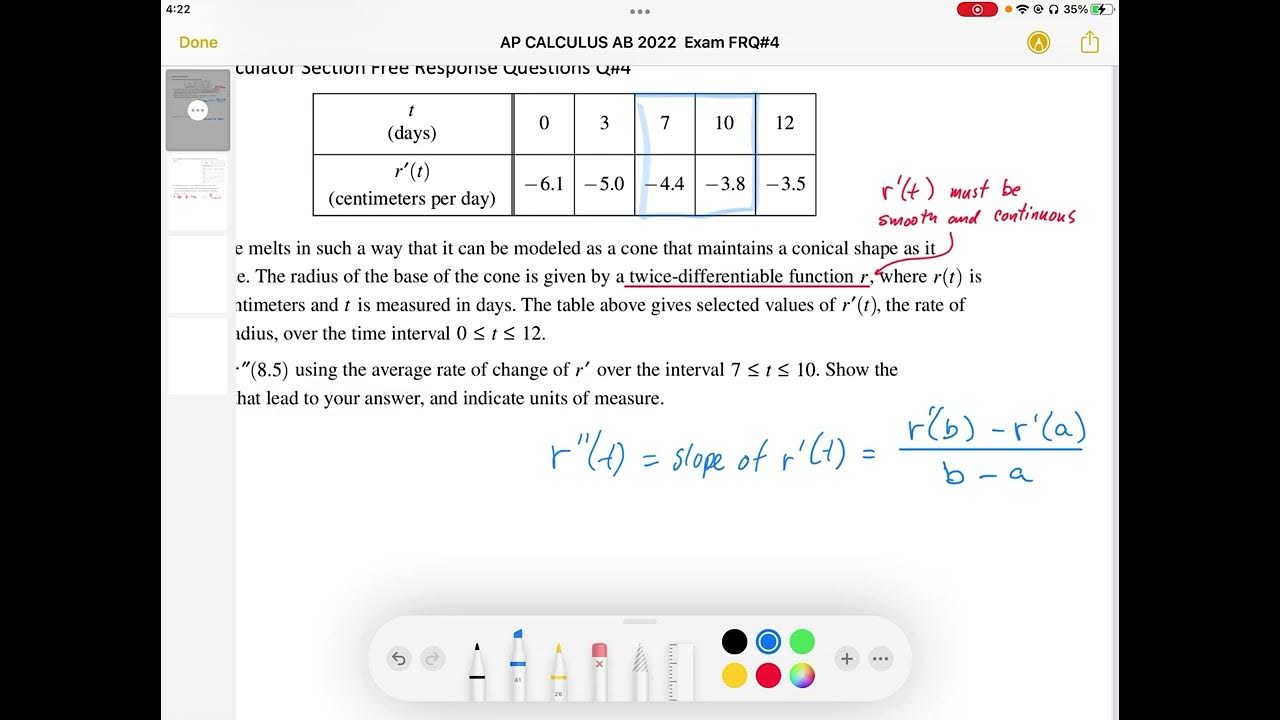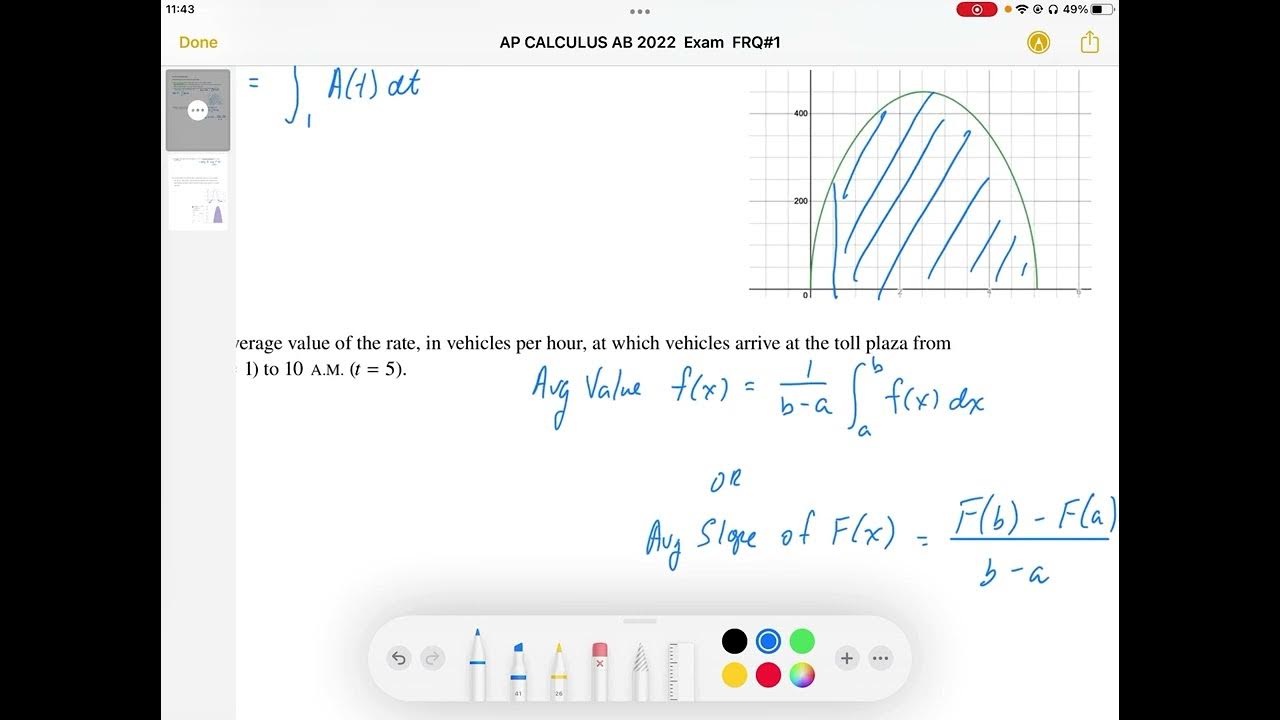Applied rate of change: forgetfulness | Applications of derivatives | AP Calculus AB | Khan Academy
TLDRThe video script explores a mathematical model to determine the rate at which a person forgets vocabulary words after studying for an English test. The model suggests that the number of words remembered, W(t), is initially 80 and decreases over time, following the function W(t) = 80 * (1 - 0.1t^2) for t between 0 and 10 days. The derivative of this function, representing the rate of change, is calculated to be W'(t) = -16 * (1 - 0.1t). By evaluating this derivative at t = 2 days, the script reveals that the rate of forgetting is 12.8 words per day at that specific point, illustrating a rapid initial decline in retention.
Takeaways
- 📚 The individual studied for an English test and learned 80 new vocabulary words, which will be the starting point for the memory model.
- 📉 It's expected that within 10 days, all 80 words will be forgotten, indicating a rapid decline in memory retention.
- 🧠 The memory retention model is given by the function W(t) = 80 * (1 - 0.1t^2) for t between 0 and 10 days.
- 🎓 The model accounts for the boundaries of the time frame, including both the start and end points.
- 🔍 To find the rate of change in the number of words remembered, the derivative of the retention function with respect to time is taken.
- 📝 Applying the chain rule, the derivative of W(t) with respect to time involves differentiating the squared term and multiplying by the derivative of the inner expression.
- 🔑 The derivative simplifies to W'(t) = -16 * (1 - 0.1t), showing a constant rate of decrease in memory retention.
- ⏱️ Two days after studying (t = 2), the rate of change is calculated by substituting t with 2 in the derivative function.
- 📉 The calculated rate of change at t = 2 is -12.8 words per day, indicating a loss of 12.8 words from memory each day at that point.
- 📚 The negative rate of change signifies that memory retention is decreasing, not increasing, at the specified time.
- 🧮 The process involves mathematical derivation and evaluation to understand the dynamics of memory retention over time.
Q & A
How many vocabulary words did the person learn for the English test?
-The person learned 80 vocabulary words for the English test.
What is the time frame within which the person will have forgotten all the words they learned?
-The person will have forgotten all the words within 10 days.
What is the mathematical model representing the number of words remembered after t days?
-The mathematical model is W(t) = 80 * (1 - 0.1t^2) for t between 0 and 10, inclusive.
What does the term 'W of t' represent in the context of the script?
-The term 'W of t' represents the number of words the person has in their head as a function of time.
How is the rate of change of the number of known words per day calculated?
-The rate of change is calculated by taking the derivative of the function W(t) with respect to time t.
What is the significance of the constant 80 in the derivative calculation?
-The constant 80 represents the initial number of words learned and does not change when taking the derivative.
What is the application of the chain rule in this context?
-The chain rule is applied to find the derivative of the expression (1 - 0.1t)^2 with respect to t.
What is the simplified form of the derivative of W(t)?
-The simplified form of the derivative is W'(t) = -16 * (1 - 0.1t).
How is the rate of change of the number of known words two days after studying calculated?
-The rate of change two days after studying is found by substituting t = 2 into the derivative W'(t).
What is the rate of change of the number of known words per day two days after studying for the test?
-The rate of change is -12.8 words per day, indicating a loss of 12.8 words per day.
What does a negative rate of change imply in the context of the model?
-A negative rate of change implies that the number of words known is decreasing over time.
How does the model account for the boundaries of the problem, specifically at t = 0 and t = 10?
-The model includes the boundaries by ensuring the function is defined for t between 0 and 10, inclusive, which is indicated by the brackets in the mathematical notation.
Outlines
📚 Memory Retention Model for Vocabulary Learning
The speaker discusses their experience studying for an English test, where they learned 80 vocabulary words. They express concern that they will forget all of them within 10 days. To model the number of words they remember over time, they introduce a mathematical function W(t) = 80 * (1 - 0.1t^2) for t between 0 and 10, inclusive. The speaker then explores the rate of change of the number of known words per day, two days after studying, by taking the derivative of the function with respect to time. Using the chain rule, they find the derivative to be -16 * (1 - 0.1t). By evaluating the derivative at t = 2, they conclude that the rate of change is -12.8 words per day, indicating a loss of 12.8 words from memory each day at that point.
Mindmap
Keywords
💡Vocabulary words
💡Memory retention
💡Forgetting curve
💡Modeling
💡Derivative
💡Chain rule
💡Rate of change
💡Constant
💡Time
💡Brackets
💡Negative rate of change
Highlights
The number of words remembered t days after studying is modeled by W(t) = 80 * (1 - 0.1t^2) for t between 0 and 10, including boundaries
The rate of change of the number of known words per day can be found by taking the derivative of W(t) with respect to time
Applying the chain rule, the derivative of W(t) is 80 * (2 * (1 - 0.1t) * (-0.1))
Simplifying the derivative gives -16 * (1 - 0.1t)
The rate of change two days after studying is found by evaluating the derivative at t = 2
Evaluating the derivative at t = 2 gives W'(2) = -16 * (1 - 0.2) = -16 * 0.8 = -12.8
The rate of change of the number of known words per day two days after studying is -12.8 words per day
This means the number of words known is decreasing by 12.8 words per day two days after studying
The model assumes that in 10 days, all 80 words will be forgotten
The model is a quadratic function of time, with a maximum at t = 0 when all words are remembered
The rate of change represents how quickly the number of known words is decreasing over time
The derivative of the model provides insight into the forgetting curve and how memory衰退declines over time
The model could be used to predict how many words will be remembered at different time intervals after studying
The model assumes that forgetting follows a quadratic function, which may not hold true for all individuals
The model could be extended to study the effects of different study techniques or复习review intervals on memory retention
The model demonstrates the power of mathematical modeling to study and understand complex phenomena like memory
The model could be used to optimize study schedules to maximize long-term memory retention
The model shows the importance of reviewing material regularly to slow down the rate of forgetting
Transcripts
Browse More Related Video
5.0 / 5 (0 votes)
Thanks for rating:





